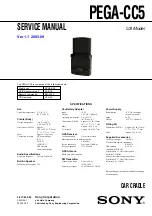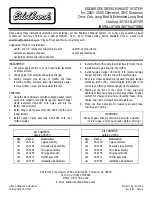
2
PEGA-CC5
Notes on chip component replacement
• Never reuse a disconnected chip component.
• Notice that the minus side of a tantalum capacitor may be dam-
aged by heat.
Flexible Circuit Board Repairing
• Keep the temperature of the soldering iron around 270 ˚C dur-
ing repairing.
• Do not touch the soldering iron on the same conductor of the
circuit board (within 3 times).
• Be careful not to apply force on the conductor when soldering
or unsoldering.
1.
SERVICING NOTES
...............................................
3
2.
GENERAL
Location of Controls .......................................................
5
3.
DISASSEMBLY
3-1. Disassembly Flow ........................................................... 29
3-2. Front/Rear Panel Assy ..................................................... 29
3-3. MAIN Board ................................................................... 29
3-4. CN Board ......................................................................... 29
4.
DIAGRAMS
4-1. Block Diagram – AUDIO Section – ............................... 30
4-2. Block Diagram – MAIN Section – ................................. 31
4-3. Note for Printed Wiring Boards and
Schematic Diagrams ....................................................... 32
4-4. Schematic Diagram – MAIN Board (1/5) – ................... 33
4-5. Schematic Diagram – MAIN Board (2/5) – ................... 34
4-6. Schematic Diagram – MAIN Board (3/5) – ................... 35
4-7. Schematic Diagram – MAIN Board (4/5) – ................... 36
4-8. Schematic Diagram – MAIN Board (5/5) – ................... 37
4-9. Printed Wiring Boards
– MAIN Board (Component Side) – .............................. 38
4-10. Printed Wiring Board
– MAIN Board (Conductor Side) – ................................ 39
4-11. Printed Wiring Board – CN Board – .............................. 40
4-12. Schematic Diagram – CN Board – ................................. 41
4-13. IC Pin Function Description ........................................... 44
5.
EXPLODED VIEW
5-1. General Section ............................................................... 53
6.
ELECTRICAL PARTS LIST
............................... 54
TABLE OF CONTENTS
UNLEADED SOLDER
Boards requiring use of unleaded solder are printed with the lead-
free mark (LF) indicating the solder contains no lead.
(Caution: Some printed circuit boards may not come printed with
the lead free mark due to their particular size)
: LEAD FREE MARK
Unleaded solder has the following characteristics.
• Unleaded solder melts at a temperature about 40 ˚C higher than
ordinary solder.
Ordinary soldering irons can be used but the iron tip has to be
applied to the solder joint for a slightly longer time.
Soldering irons using a temperature regulator should be set to
about 350 ˚C.
Caution: The printed pattern (copper foil) may peel away if the
heated tip is applied for too long, so be careful!
• Strong viscosity
Unleaded solder is more viscou-s (sticky, less prone to flow)
than ordinary solder so use caution not to let solder bridges oc-
cur such as on IC pins, etc.
• Usable with ordinary solder
It is best to use only unleaded solder but unleaded solder may
also be added to ordinary solder.
Содержание PEGA-CC5
Страница 61: ...61 PEGA CC5 MEMO ...



































